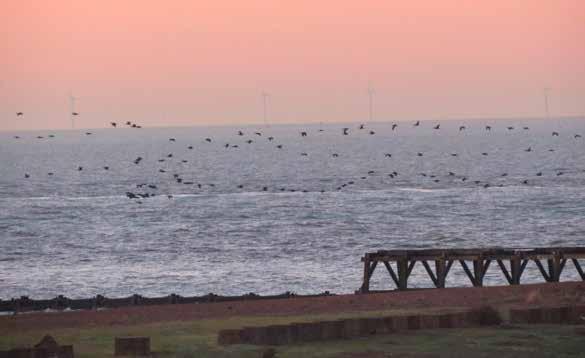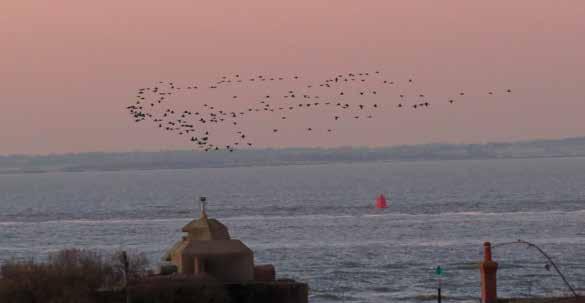
3 minute read
Cormorants #1 ....................................................................... Nigel Odin
Nigel Odin
Winter Cormorant movements over Landguard Bird Observatory, Suffolk
The number of Great Cormorants Phalacrocorax carbo recorded at Landguard Bird Observatory has increased in recent times. Prior to the winter of 2016/2017 no count had reached four figures with a peak count of 958 on 17th January 2016. The usual pattern of occurrence is for counts to increase rapidly from in the single figures late October, peaking mid-January and declining rapidly again mid-February to single figures in early March. During the winter of 2016/2017 counts went through the roof with peaks off 3020 25th December 2016, 3253 January 16th 2017 & 3100 January 22nd 2017. Birds are counted early in the morning flying overhead in an easterly or southeasterly direction straight out to sea to the sandbanks around the area of the Cork Sands. If the tides are low, birds sit on parts of the exposed sandbanks making them look like a distant oil slick. Some birds can be seen returning inland before the last few birds have gone out suggesting that the sea fishing is extremely productive and they can fill their bellies for the day in the matter of a few minutes fishing. After an hour or so most remaining birds have departed to the north, having either finished fishing or being forced off the sand banks by changing tidal conditions. Counts are very cyclical in nature often declining into only double or low three figure counts for a few days before returning to high levels. The exact reason for the erratic numbers counted was suspected as being linked to culling. A simple request for information on when this was taking place
at the birds roost at Trimley was made to Natural England. Presumably due to the sensitive nature of this topic this was passed onto a solicitor in London to be treated as a “Freedom of Information” request. A reply came back within the statutory time for such requests that was very detailed on information that was not requested but was deliberately obfuscate on when culling was being carried out. The request was so that counts over Landguard could be scientifically correlated with times of disturbance at the roost. As such it can be assumed that English Nature issue licences for shooting but do not bother monitoring when and what is actually going on at the trout lake. It is well known that killing Cormorants has no effect on the overall populations of these birds and with persecution of the species either legally, or illegally, widespread which causes numbers to rapidly increase at some sites as disturbed birds quickly return bringing their congeners back with them (Chamberlain et al. 2013). Wintering populations have increased in line with an increase in breeding numbers to the east of Britain on mainland Europe (Frost et al. 2016). The bulk of the wintering birds will be females and immatures from the Low Countries, southern Scandinavia and the areas around The Baltic (https://www.bto. org). If the numbers counted in the winter of 2016/2017 are maintained then the roost at Trimley and the feeding areas offshore will qualify the area as being of international importance for the species as they equate to almost 10% of the entire British wintering population.
References: Chamberlain, D.E., Austin, G.E., Green, R.E., Hulme, M.F. & Burton, N.H.K. (2013) Improved estimates of population trends of Great Cormorants Phalacrocorax carbo in England and Wales for effective management of a protected species at the centre of a human–wildlife conflict. Bird Study 60: 335–344. Frost, T.M., Austin, G.E., Calbrade, N.A., Holt, C.A., Mellan, H.J., Hearn, R.D., Stroud, D.A., Wotton, S.R. and Balmer, D.E. 2016.Waterbirds in the UK 2014/15: The Wetland Bird Survey. BTO/RSPB/JNCC, Thetford.
Nigel Odin, Landguard Bird Observatory, View Point Road, Felixstowe, Suffolk IP11 3TW










